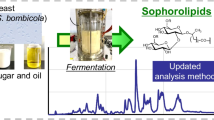Abstract
Members of the bacterial genus Sphingomonas are known to produce highly viscous polysaccharides in solution. The exopolysaccharide PS-EDIV was produced by Sphingomonas pituitosa strain DSM 13101, purified using centrifugation, and precipitation and its structure was elucidated by 1D and 2D NMR techniques and chemical microderivatization combined with various mass spectrometric techniques. The following repeating unit of the polysaccharide could be identified:

In addition, the polysaccharide also contains acetyl and glyceryl groups whose exact positions were not determined. PS-EDIV is similar in structure to a known exopolysaccharide but differs in being the first bacterial polysaccharide in which two different glucuronic acids are combined. It caused a high viscosity of the culture broth after cultivation for 48 h, although a gelation was not observed.





Similar content being viewed by others
References
Anumula KR, Taylor PB (1992) A comprehensive procedure for preparation of partially methylated alditol acetates from glycoprotein carbohydrates. Anal Biochem 203:101–108
Balkwill DL, Fredrickson JK, Romine MF (2005) Sphingomonas and related genera. In: Dworkin M (ed) The prokaryotes: an evolving electronic resource for the microbiological community. Springer, Berlin Heidelberg New York
Chaplin MF (1982) A rapid and sensitive method for the analysis of carbohydrate components in glycoproteins using gas–liquid chromatography. Anal Biochem 123:336–341
Cowie JMG (1997) Chemie und Physik der synthetischen Polymere. Vieweg, Braunschweig
Denner EBM, Paukner S, Kämpfer P, Moore ERB, Abraham W-R, Busse H-J, Wanner G, Lubitz W (2001) Sphingomonas pituitosa sp. nov., an exopolysaccharide-producing bacterium that secretes an unusual type of sphingan. Int J Syst Evol Microbiol 51:827–841
Falk C, Jansson P-E, Rinaudo M, Heyraud A, Widmalm G, Hebbar P (1996) Structural studies of the exocellular polysaccharide from Sphingomonas paucimobilis strain I-886. Carbohydr Res 285:69–79
Fialho AM, Martins LO, Donval ML, Leitão JH, Ridout MJ, Jay AJ, Morris VJ, Sà-Correia I (1999) Structures and properties of gellan polymers produced by Sphingomonas paucimobilis ATCC 31461 from lactose compared with those produced from glucose and from cheese whey. Appl Environ Microbiol 65:2485–2491
Hashimoto W, Okamoto M, Hisano T, Momma K, Murata K (1998) Sphingomonas sp. A1 lyase active on both poly-b-d-mannuronate and heteropolymeric regions in alginate. J Ferment Bioeng 86:236–238
Kang KS and Veeder GT (1985) Heteropolysaccharide S-88. U.S. Patent 4,535,153
Kang KS, Veeder GT (1982) Polysaccharide S-60 and bacterial fermentation process for its preparation. U.S. Patent 4,326,053
Kwon B-D, Foss PA, Rha C (1987) Rheological characterization of high viscosity polysaccharides. In: Yalpani M (ed) Industrial polysaccharides: genetic engineering, structure/property relations and applications. vol. 3. Elsevier, Amsterdam, pp 253–266
Lobas D, Nimtz M, Wray V, Schumpe A, Proppe C, Deckwer W-D (1994) Structure and physical properties of the extracellular polysaccharide PS-P4 produced by Sphingomonas paucimobilis P4 (DSM 6418). Carbohydr Res 251:303–313
Lobas D, Schumpe A, Deckwer W-D (1992) The production of gellan exopolysaccharide with Sphingomonas paucimobilis E2 (DSM 6314). Appl Microbiol Biotechnol 37:411–415
Martins LO, Fialho AM, Rodrigues PL, Sá-Correia I (1996) Gellan gum production and activity of biosynthetic enzymes in Sphingomonas paucimobilis mucoid and non-mucoid variants. Biotechnol Appl Biochem 24:47–54
Peik JA, Steenbergen SM, Hayden HR (1983) Heteropolysaccharide S-194. U.S. Patent 4,401,760
Podolsak AK, Tiu C, Saeki T, Usui H (1996) Rheological properties and some applications for rhamsan and xanthan gum solutions. Polym Int 40:155–167
Pollock TJ (2002) Sphingan group of exopolysaccharides (EPS). In: Vandamme EJ, De Baets S, Steinbüchel A (eds) Biopolymers—polysaccharides I. Wiley-VCH, Weinheim, pp 239–258
Acknowledgements
We thank Steffen Harling of the Institute for Technical Chemistry, TU Braunschweig, for performing gel permeation chromatography. We are also grateful to Professor Werner Lubitz of the Department of Medicinal Chemistry, University of Vienna, Austria, for providing us with the organism S. pituitosa and additional information.
Author information
Authors and Affiliations
Corresponding author
Rights and permissions
About this article
Cite this article
Schultheis, E., Dreger, M.A., Nimtz, M. et al. Structural characterization of the exopolysaccharide PS-EDIV from Sphingomonas pituitosa strain DSM 13101. Appl Microbiol Biotechnol 78, 1017–1024 (2008). https://doi.org/10.1007/s00253-008-1383-8
Received:
Revised:
Accepted:
Published:
Issue Date:
DOI: https://doi.org/10.1007/s00253-008-1383-8




